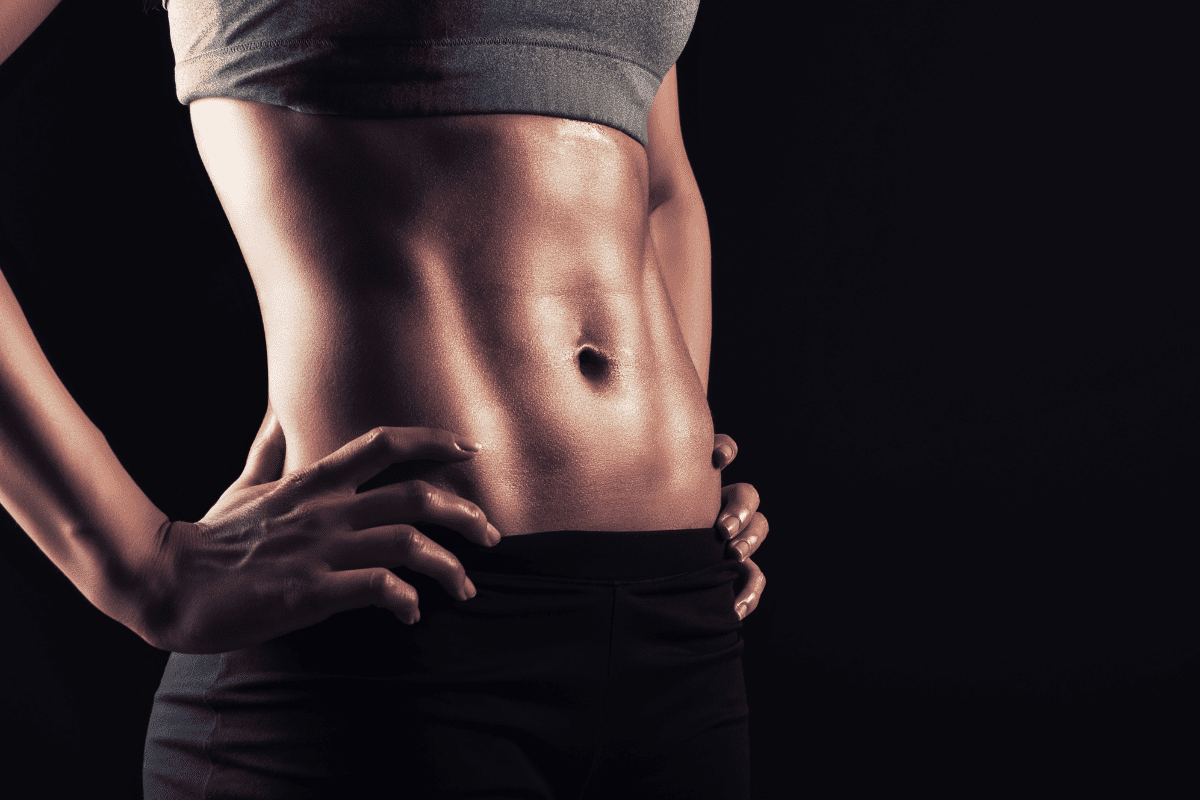14 Reverse Crunch Alternatives To Work The Core
Reverse Crunches are a simple yet extremely effective core exercise. They work the entire abdominal area (especially the lower abdominals) and don’t require any equipment.
However, sometimes you may find yourself wanting an alternative exercise for Reverse Crunches. You may not be a fan of Reverse Crunches or maybe you just want to add some variety to your workouts.
Whatever the reason, you’re in the right place. In this guide, I’m going to give you 14 of my favorite exercises that can be used to replace Reverse Crunches.
Alternatives to Reverse Crunches
I’ve tried to include as much variety in this list of alternative exercises as possible. Some exercises are bodyweight exercises just like Reverse Crunches, others include basic equipment like a pull-up bar or a medicine ball.
My goal was that no matter what equipment you have access to and no matter what your level of lifting experience is, one of the exercises will fit what you’re looking for.
Crunches
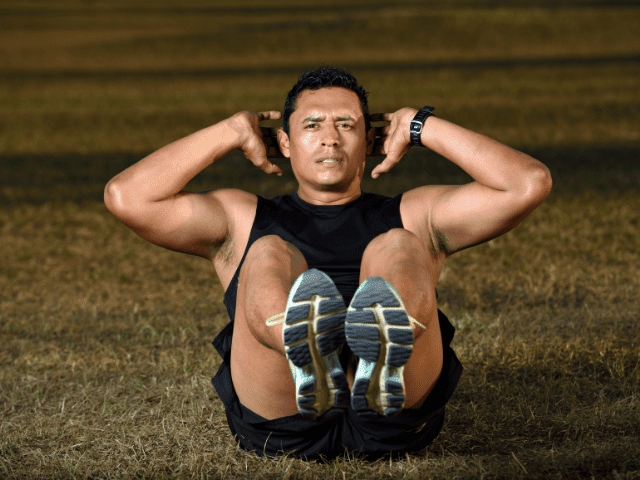
Equipment Needed
- None
How To
- Lay flat on your back with your knees bent to 90 degrees, feet off the ground
- Place your hands behind to head and keep your chin off you chest throughout the entire movement
- Lift your shoulder blades off of the ground approximately 3 to 5 inches
- Slowly return to the starting position and immediately repeat the exercise until all reps are completed
Coaching Points
Do not pull on the back of the head when doing Crunches. The hands behind your head should only be there to support the head, not pull on it. Keeping your chin up and away from your chest will help in preventing this.
Front Plank

Equipment Needed
- None
Step-by-Step Instructions
- Start on the ground on your stomach.
- Assume a push-up like position on your elbows and toes. Elbows should be directly under the shoulders.
- Position your body in a straight line from the shoulders through the hips, knees and ankles.
- Brace the core tight. (As if you’re going to be punched in the stomach)
- Do not let the body slouch to the ground nor push the hips up high in the air.
- Hold for the designated amount of time.
Coaching Points
The biggest mistake that I see with Front Planks is athletes holding the position, but not properly keeping the core engaged and just allowing the torso to slouch. So, while they are technically up on their elbows and toes, all they’re really doing is straining the low back.
Suitcase Crunches
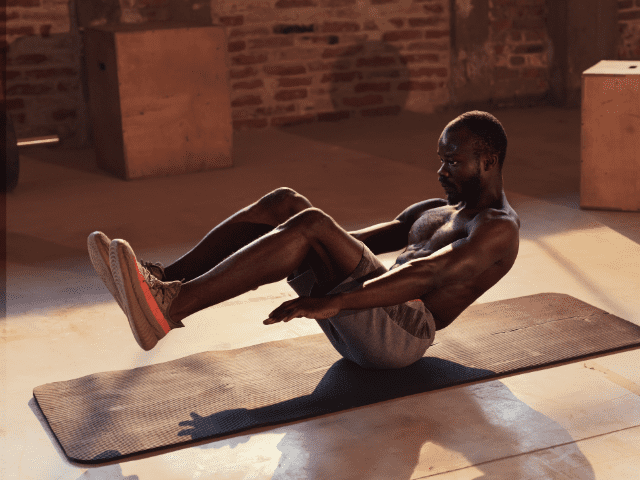
Equipment Needed
- None
Step-by-Step Instructions
- Start by sitting on the ground, balancing on your butt with legs and back up off the ground.
- Legs should be almost straight, feet roughly six inches off the ground. Torso should be leaned back at about a 30-degree angle.
- From the starting position, crunch up, bringing the knees and chest together above the hips (like a suitcase shutting)
- Lower back to the starting position and repeat until all reps are completed. (Feet and back should stay off the ground throughout the movement)
Coaching Points
If you keep your feet uncrossed during the movement, your groin will be forced to stay engaged. This creates a small added bonus to Suitcase Crunches.
Medicine Ball Slams
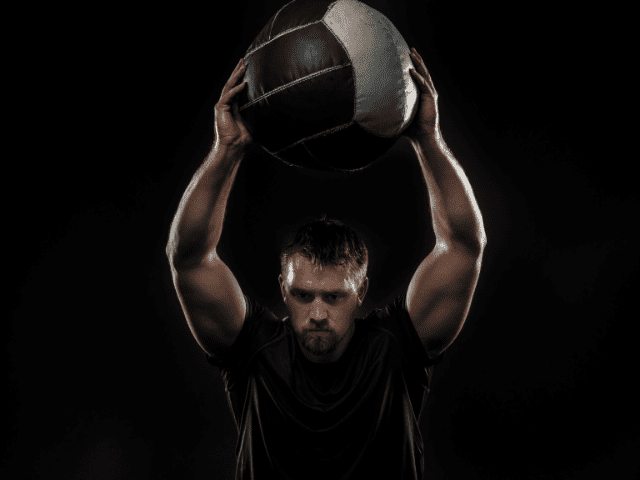
Equipment Needed
- Medicine Ball (it’s literally in the name)
Step-by-Step Instructions
- Grab a medicine ball and stand tall with feet roughly shoulder-width apart.
- Reach the medicine ball high overhead.
- Using the core, pull the body down – hinging forward at the hips.
- Follow through with the arms and release the ball.
- Let the ball slam into the ground, catch it off the bounce and repeat for the designated number of reps.
Coaching Points
First and foremost, test how ‘bouncy’ your medicine ball is before starting. I can’t tell you how many times I’ve seen athletes almost have their face smashed by a Medicine Ball Slam bouncing much harder and rebounding much faster off the ground than they were anticipating.
Cable Crunches

Equipment Needed
- Cable Machine
Step-by-Step Instructions
- Set up a cable machine at a height where the attachment can reach close to the floor.
- Grab the attachment*, pull it to the back of the shoulders (similar to a back squat) and sit down on your knees.
- Start with the torso completely upright.
- Then, crunch down, taking your shoulders down towards your thighs.
- Slowly return back to the starting position and repeat.
Coaching Points
*The two most popular attachment to use for Cable Crunches is the rope and the long straight bar. I would suggest trying both and seeing which you like better.
Dead Bug
Equipment Needed
- None
How To
- Begin by lying on the floor on your back.
- Raise both arms straight up toward the sky.
- Bend both knees at a 90-degree and raise the legs until the knees are directly vertical of the hips.
- Brace the core and simultaneously lower the right leg and left arm toward the floor.
- The arm should end up six inches from the ground directly overhead.
- The leg should end up six inches from the ground directly below the hip.
- Return both back to the starting position and then lower the opposite arm and leg.
- Continue alternating back and forth, pausing and ‘locking-in’ each rep.
Coaching Points
The back will naturally want to arch as you go through Dead Bugs. Try not to let it. Keep the core braced and maintain a neutral torso.
Seated Twist
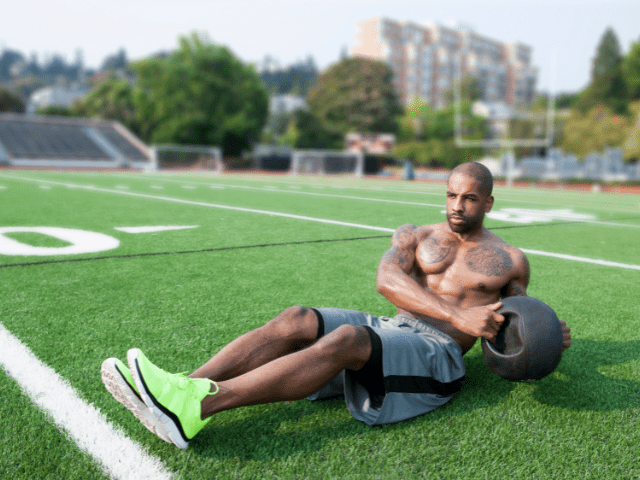
Equipment Needed
- Medicine Ball
Step-by-Step Instructions
- Start by taking a seat on the floor and clasping your hands together.
- Slightly bend the knees and raise your feet roughly six inches off the floor.
- Start by rotating your torso to the left, taking your right elbow toward your left knee.
- Now turn your shoulders and rotate your torso to the right, now taking your left elbow toward your right knee.
- Keep legs mostly still and maintain the feet off the floor throughout the movement.
- Continue rotating back and forth until all reps are completed.
Coaching Points (Common Mistakes)
The biggest mistake I see with my athletes when doing Seated Twists is moving their hands back and forth instead of rotating through the core. The focus should be on the rotation. What the hands and arms do is merely a product of rotating through the torso.
Stir The Pot
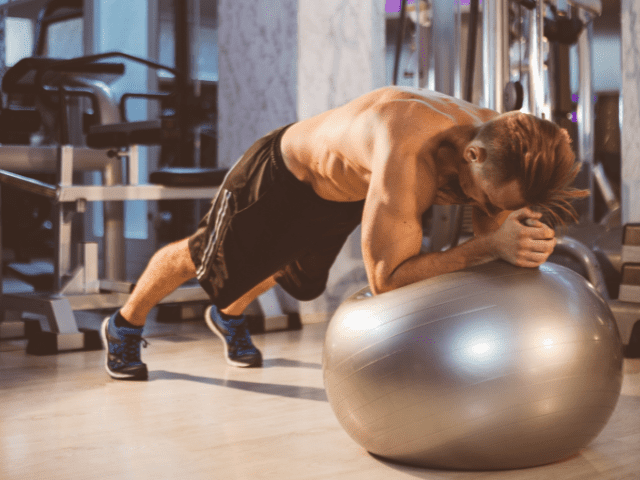
Equipment Needed
- Stability Ball (also sometimes called a Physio Ball)
Step-by-Step Instructions
- Start on your knees with the Stability Ball directly in front of you.
- Place your forearms on the ball and clasp your hands together.
- Now slowly lift up off of your knees, balancing yourself with your forearms on the ball and toes on the ground.
- You should now basically be in plank position, but with your forearms on a stability ball instead of the ground.
- Now work your hands into small circles. This should simulate, you guessed it, stirring a pot with a big wooden spoon.
- Work clockwise until all reps are completed and then switch and go counter-clockwise as well.
- Once all reps are completed lower back down to your knees.
Coaching Points
Take your time getting properly set up! If you’ve never done Stir the Pot before it can be surprising just how hard it is to balance yourself on a stability ball in this manner let alone shift in circles.
Hanging Straight Leg Raises
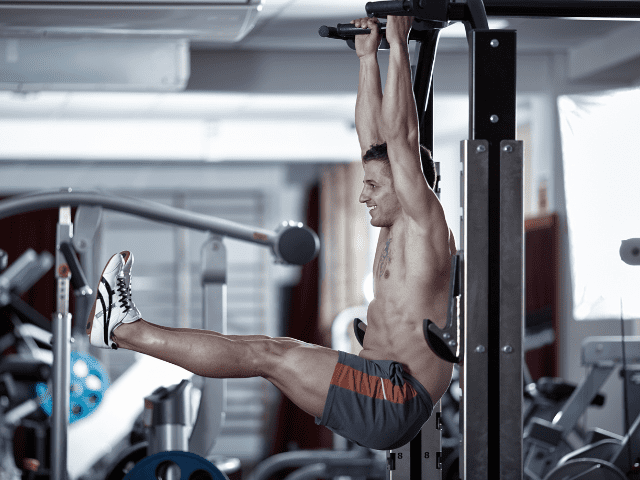
Equipment Needed
- Pull-Up Bar – Ideally a stand-alone pull-up bar or one connected to a squat rack although any sturdy object you can hang from will technically work.
Step-by-Step Instructions
- Find yourself a pull-up bar and grip the bar with an overhand grip.
- Engage your lats so your body doesn’t go limp once you begin to hang.
- Now hang from the bar and keeping your legs straight, drive them up to hip height (or slightly above hip height).
- Finally, actively lower your legs back to the starting position – don’t allow the legs to just swing down.
- Repeat until all reps are completed.
Coaching Points
The biggest issue that most of my athletes run into when doing Hanging Straight Leg Raises (or any hanging ab exercise for that matter) is how to keep from swinging out of control.
Toe Touches
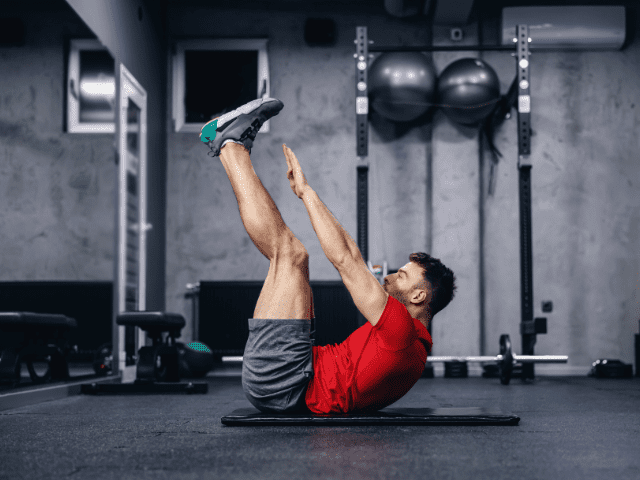
Equipment Needed
- None
How To
- Lay flat on your back with your legs perpendicular to the floor (legs straight up in the air).
- From this position, keep your chin off of your chest, keep your arms straight and raise your upper body toward your feet.
- Touch your toes (or at least reach as high up your shins as you can) with your fingers and return to the starting position.
- Repeat the exercise until your set is complete.
Coaching Points
Athletes with tight hamstrings may find it hard to keep their legs straight up in the air when doing Toe Touches. Work to keep legs straight and vertical as much as possible.
Ab Rollouts
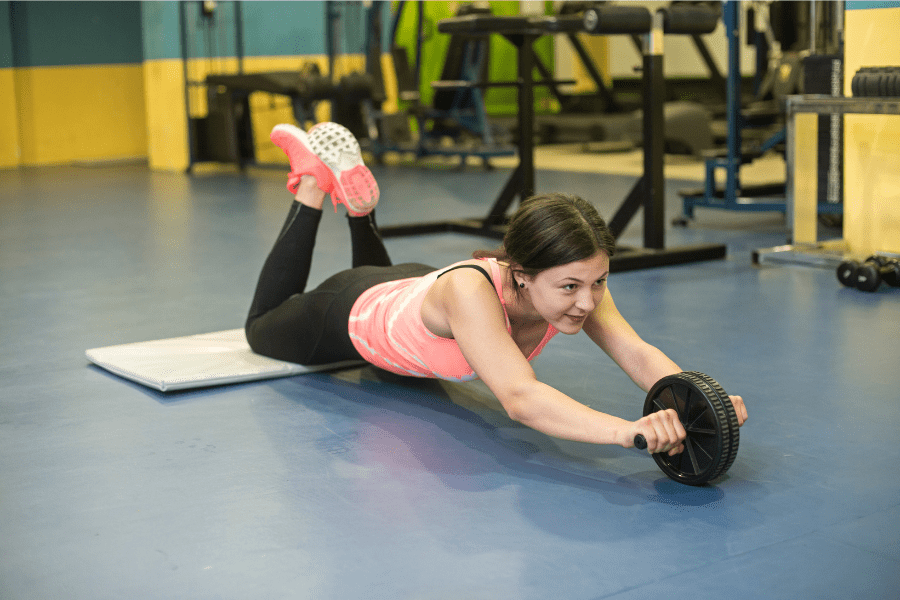
Equipment Needed
- Ab Wheel
OR
- Barbell with Bumper Plates on each side
How To
- Start on your knees with your hands on the Ab Wheel handles.
- Brace the core hard and begin rolling the wheel forward.
- Roll out until you feel you’re about to fall and then begin pulling the wheel back.
- Repeat until all reps are completed.
Coaching Points
Don’t allow your hips to stay behind you as you begin to roll forward. Hips should stay relatively in line with the knees and shoulders, similar to a Plank.
Single Leg Pallof Press
Equipment Needed
- Resistance Band (Preferably a thin one)
- A Band Anchor (A squat rack works perfectly)
Instructions
- Start by looping a band around the vertical beam of a squat rack.
- Stand far enough away from the rack to get proper tension on the band. You should feel the band pulling and trying to rotate you, but not so much that you cannot maintain your balance.
- Grab the band with one hand and then place the other hand over top.
- Start with your hands right in front of your sternum.
- Lift the leg furthest away from the rack up off the ground.
- Now, in a controlled tempo, press the band straight out in front of you and then return it to the starting position.
- Repeat for the required amount of reps.
Coaching Points
Keep Single Leg Pallof Presses slow and controlled. Don’t rush through the exercise.
Try to keep the opposite foot off the ground for the duration of the set. Touch the ground only if necessary to regain balance.
Lateral Planks

Equipment Needed
- None
Step-by-Step Instructions
- Lay on your side, one elbow down and feet, hips and shoulders stacked vertically above one another.
- The opposite hand (non-support arm) can be placed on the hip or held up in the air.
- Hold this position for the designated amount of time.
Coaching Points
The biggest mistake I see with my athletes with Lateral Planks is allowing the top shoulder to hunch forward. Both shoulders (along with hips and feet) should be stacked directly above each other. Do not allow yourself to twist forward toward the ground with your upper body.
Single Arm Farmer’s Walk
Equipment Needed
- Dumbbell or Kettlebell
How To
- Grab a single kettlebell or dumbbell.
- Brace the core and begin walking in a slow, controlled manner.
- As you walk, focus on keeping the core braced and the shoulders and hips square and level.
- Once you cover the assigned distance (or time), switch hands and repeat on the opposite side.
Coaching Points
You do not need to grab the heaviest kettlebell you can find for Single Arm Farmer’s Walks. Find a weight that you can walk with and maintain proper form.
Final Thoughts
Reverse Crunches are an excellent exercise for developing a strong core, however, sometimes you may want a substitution for them.
In these situations, you’ll need a Reverse Crunch alternative and I hope that at least one of the alternative exercises I’ve listed here fits what you were looking for.

